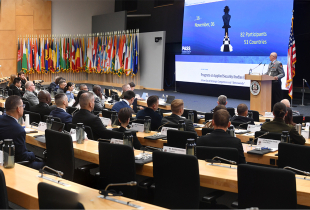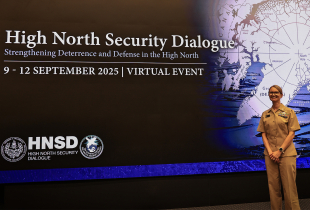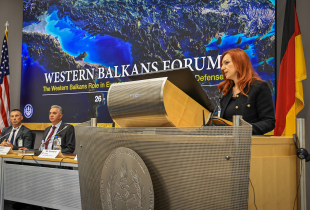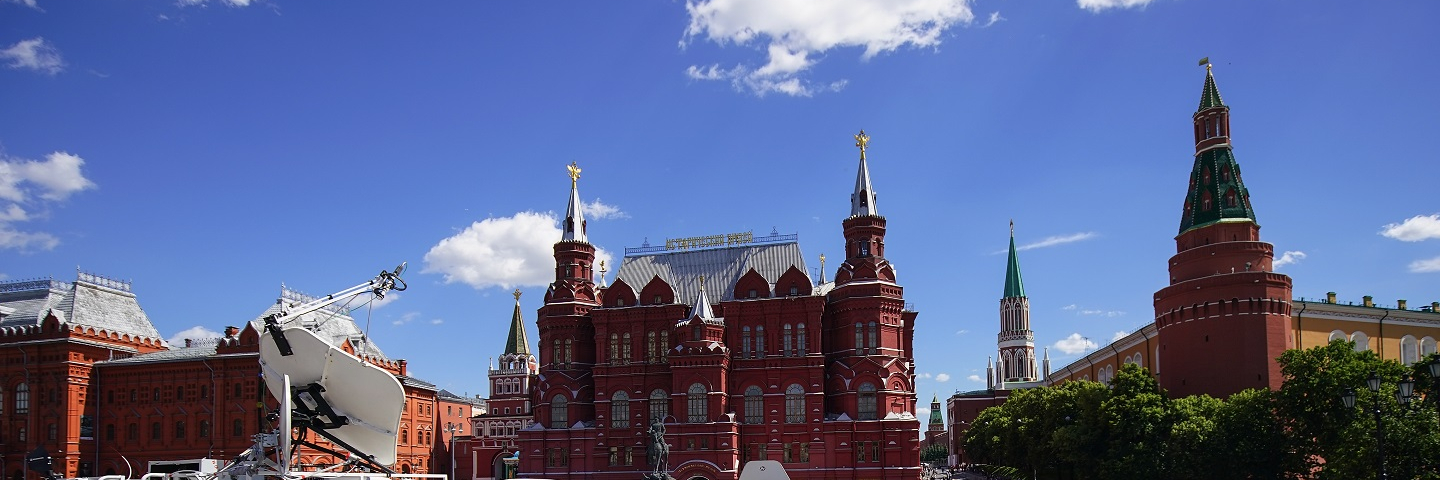
Hybrid Threats and Strengthening Resilience on Europe’s Eastern Flank
Executive Summary
Between 23-27 January 2017, the George C. Marshall European Center for Security Studies, brought together sixty civilian and military mid- to senior level security policy practitioners and experts from twenty-six countries in order to collaborate on the second European Security Seminar-East (ESS-E). The group’s task was to explore how to address the hybrid threats and contribute to making the West, as redefined since the end of the East-West conflict, more resilient against them. However, the definition of the prospects had to be based on an accurate and realistic assessment of the security situation and the concerns that are associated with the security challenges emerging in Europe’s east. The meeting was held at a turbulent and somewhat unpredictable time, during the week after the inauguration of U.S. President Donald Trump, a few months after the Brexit referendum and a week before the renewed intensification of hostilities in the south-east of Ukraine between the Ukrainian armed forces, the separatists and those that back the latter. As the seminar addressed potential responses to hybrid threats, including building resilience to counter them, it faced the challenge of working with ill-defined categories and overcoming disagreements as far as their meaning and interpretation.
Hybrid Threats
Hybrid threats and hybrid warfare are not new. Although they were initially identified with conflicts involving a combination of conventional military forces and irregulars (both in state service and those of non-state actors) the concept has recently evolved and morphed. For the purposes of this seminar, the decisive change came with the publication of the so-called Gerasimov doctrine in late 2013, which was soon followed by the annexation of Crimea and later by the massive Russian involvement in the separatist activities in the Donetsk and Luhansk area in the south-east of Ukraine. Although it is open to question whether it is possible to speak about hybrid threats, hybrid warfare, and hybrid operations as new phenomena, it is certain that Russia’s strategy has somewhat redefined the old concept. The novelty is the combination of the above with an intense information (most often disinformation) campaign. Both military and non-military tools are integrated and psychological and diplomatic means are extensively used. Sophisticated and rapid information campaigns and the use of electronic means, including cyber operations, are also part and parcel of Russia’s hybrid activities. Those elements are integrated better than ever, with the emphasis tilting toward non-military methods and in some contexts information warfare. A country using hybrid warfare can most effectively deploy information campaigns (including “fake news”) in targeted countries and territories where at least a part of the population is receptive to such messages; this is particularly effective in situations where the targeted population, including ethnic minorities, already use the language of the hybrid warfare-implementing country as their mother tongue. Last but not least, dissatisfaction with the country’s government, doubts about the information it spreads, and distrust and corruption in the national government also foster the credibility of information operations as part of hybrid warfare.
In light of the above, it is possible to fairly accurately calculate which states and territories are likely to be targets of the Russian Federation’s hybrid warfare efforts, adjusted to the circumstances of the specific country or region. In other cases, information campaigns, economic influence, symbolic gestures based on civilizational and historical roots, and shared religion may result in interference, attempts to undermine national unity, and to help marginal political forces to gain more influence in democratic polity by manipulating political processes. Moscow has made sustained efforts to create dependencies through the use of a broad variety of means, including corrupting politicians as part of advancing Russian projects, Russian participation in privatization, and financial support to extremist parties with the aim of destabilizing various countries. In those cases, however, the objectives may be either more limited or different than in the prime “targets” of hybrid operations, like Ukraine. In an atmosphere where hybrid means have been used to the limits of camouflaged high intensity military operations, it is difficult not to “cry wolf” and address situations as if the hybrid warfare terminology would apply to them all. Such operations included the employment of regular armed forces in violation of the Geneva conventions (e.g. not wearing insignia and hiding their identity in Crimea, complemented by the activity of so-called “little green men”), and support with strategic guidance, intelligence, weapons and armed forces personnel the separatist forces in the Donbass. It is clear the assessment of hybrid threats is interpreted in a national and regional context and presents different dangers for states with different conditions.

The Russian Federation has not, however, confined its activity geographically to parts of the former Soviet Union. It has extended their efforts to the Western Balkans, though, for example, an attempt to influence election results, followed by a coup attempt, in NATO accession state Montenegro, and also by an increase in Russia’s activities and influence in other states, certainly including Albania, Serbia, and Bosnia and Herzegovina. In states that have been integrated into the EU and NATO, efforts focus on presenting the Russian version of political information, including fake news, and influencing the countries’ domestic politics in order to drive internal wedges into the EU and the Atlantic Alliance. The goal is to create divisions both inside Europe and between the U.S. and Western Europe. The latter goal is not new as it had also been the Soviet Union’s long-held intention to weaken U.S. involvement in European affairs. This has also been Moscow’s aim under the assumption that a Europe without the U.S. provides the Soviet Union/Russia more room to maneuver. Certain states are prioritized on Moscow’s agenda, including Cyprus, France, Greece, Hungary, Italy, Latvia, and Turkey. In other cases, Russia prioritizes certain political figures over others; consider, for instance, the Czech Republic where Russia supports the pro-Russian president Milos Zeman against the government. Russian information providers have complemented television programs like Russia Today, which broadcasts in languages like English, French, Spanish, and Arabic, with low cost internet sites. If the nature of a website is identified it is flexibly “switched off,” while new ones begin spreading the Russian version of news and analysis. Other Russian information outlets like Sputnik News are more permanent and their quality has improved, both with regard to raising doubts about the information spread by the western media and implementation (e.g. the quality of translation into rare languages). Targeted hacking has also reached western political authorities ranging from the Democratic Party (the Democratic National Committee) in the U.S. to the German Parliament, to mention but two notable cases. It is premature to conclude how the eventual hacking of elections in western states influences their organization, or the electorate’s trust in democratic processes.
Hybrid threats represent an elusive and fragmented concept, which uses a different mix of means in various contexts. While in the post-Soviet space, hybrid threats mean the inclusion and employment of military means and not only their use as deterrent, in the context of the West, hybrid threats represent a different mix that attacks the western way of life in its elements. In this context, the various elements are not particularly aggressive on their own, but taken together they are indeed aggressions. The challenge is to assemble the pieces of a mosaic and conceptualize the picture in order to gain a correct understanding of the situation. The accelerated use of such threats possible due to technological advancement and their nature means that the legal system is slow in catching up and formulating legal structures to address these facts and make a difference.
One of the most difficult choices for democracies has been to effectively address the challenge posed by the broad array of information operations while maintaining the liberal political order and respect for human rights and fundamental freedoms, including freedom of speech and the media. With hybrid operations, however, Russia exploits a vulnerability of the West that the West cannot easily abandon without hurting itself. The action taken by the Council of Europe and the European Parliament with respect to the television outlet Russia Today illustrated the dilemma, ranging from identifying Russia Today as a frequent source of fake news but falling short of banning it from broadcasting. These Russian information campaigns take advantage of the democracy-based liberal order without providing similar access to their own media space. However, the Russian Federation assesses the situation quite differently. Russian politicians speak about breaking the information monopoly of the West, one which understandably upsets Moscow. According to Russia, the West has no alternative but to live with this.
It is not clear what Russia would like to achieve with its various efforts. Does it want to change the territorial status quo as it has done in Georgia and in Crimea or the political status quo as in the Donbass? Last but not least, it cannot be excluded that in the broader European and Euro-Atlantic context Russia would simply like to assert its influence and thus achieve the status of a well-established pole of a multi-polar international order, a status to which Russia has aspired for more than a decade. It is apparent that different aspirations would require different reactions. However, the often reiterated pragmatism of Russia in international relations as well as its application of tailor-made methods to various countries and target groups does not make it easy to draw uniform conclusion as far as its aspirations.
Resilience and Resilience-Building
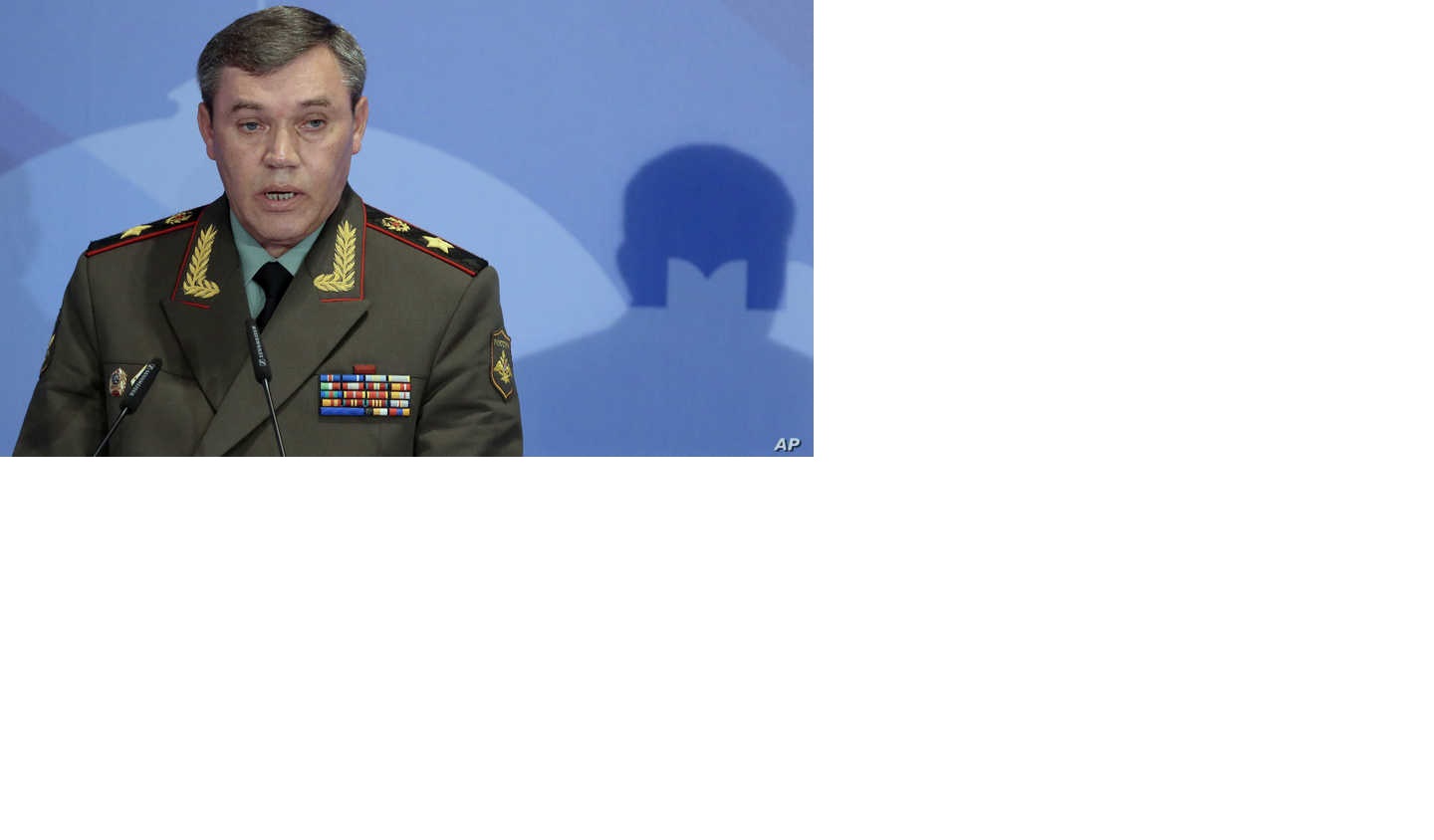
The concept of resilience has just as many meanings as hybrid threats. Resilience is about how states and societies resist collapse under the impact of disastrous events. They have to cope and deal with such events, adapt to them, and recover from their effects in a short period of time. It is obvious that post-facto resilience is only possible if the state and the society are able to anticipate the potential consequences of a series of events, be it man-made, a natural disaster, or an external challenge, like a crisis or war. Consequently, resilience is contextual; it has many forms dependent upon the context.
Resilience has much to do with state capacity, governance, and the cohesion and thus the support of society for its state institutions and leaders. Hence, it would be easy to draw the conclusion that there are so many factors contributing to resilience that it would be the best to identify the concept with good governance. However, this would be a gross simplification as resilience must be developed in anticipation of scenarios that are likely to occur. This harks back to resilience in those areas from whence the challenge comes. This is complicated by the perceptional foundations of analysis and further by a number of other factors, including:
- Those problems that are of low likelihood but extremely high risk (e.g. a nuclear attack or a major reactor accident) and cannot be ignore
- No state has unlimited resources, and hence the priority areas must be backed by resource allocation. This may be easier said than done as there is rivalry for resources on the national agenda. Furthermore, due to various factors, some states—irrespective of their national efforts—cannot become resilient against certain concentrated, high intensity challenges. One could conclude that most of Europe can interpret resilience only in the international context complementing national efforts.
- Any single state that introduces a hybrid threat is a unitary actor that can decide its course of action more easily than the state under attack. A state initiating a hybrid offensive and in so doing provokes a need for reaction has an advantage over states in Western and East- Central Europe that must demonstrate resilience, as the state utilizing hybrid methods can make decisions on its own, but the allied countries in Western and East-Central Europe must in reaction rely on resources of other states in a common regional organization or alliance. The Russian Federation, for instance, has an effective and centralized decision-making system and does not have to worry about the compromises that democracies have to make.
What the Russian Federation Sees and What It Does?
Despite the passing of a quarter of a century since the dissolution of the Soviet Union and more than thirty years since its noticeable decline, the Russian Federation faces difficulties in accepting the new power relations as they have evolved since the end of the East-West conflict. It sees a world that is unjustifiably unipolar, one in which a single country, the United States, still plays a decisive role and the others either accept the role of transmission belts or are otherwise subjected to its will. This has severely curtailed the sovereignty of most other actors, eliminated respect for the principle of non-interference in internal affairs, resulted in selective use of force, and arbitrarily prioritized the right to self-determination. Moreover, Russia gained no recognition for its cooperative stance in the 1990s. To the contrary, the West took advantage of Russia’s weakness and exploited it to its own benefit, ignored Moscow’s interests, changed the status quo, and extended its sphere of influence.
Since the beginning of the twenty-first century, the Russian Federation has regained its strength and self- confidence. Its GDP has tripled, order has replaced the chaos that characterized the late Yeltsin years, and Moscow has used these changes to make efforts to reestablish its international influence. Short of any other point of reference, Russia has in part returned to a realist agenda that also has Marxist-Leninist roots as far as “victory over power can only be achieved by power.” Economic success based on high commodity prices has made resource diversification possible. Russia spent the windfall on the following:
- Modernizing the defense sector, which was necessary due to the low investment that had gone into it for a long period of time.
- Allocating resources to various parts of the society in order to maintain social cohesion and also forming a national middle class.
- Implementing prestige projects often closely associated with corruption and cronyism.
A relatively small share was allocated to the diversification and modernization of the economy and producing high value added consumer goods, and to contributing to the development of the less developed regions. With this, Russia has underlined the general observation that commodity exporter economies do not modernize when commodity prices are high as they do not feel the need, but they also do not modernize when commodity prices are low as they do not have the resources. With this, the Russian Federation continued to rely on its strengths while maintaining its weaknesses. Therefore its power base has remained insufficiently diverse. The Russian leadership, in particular those who have had little aptitude and devoted little interest to the economy, have seen a country that has regained its strength while others—those with an economic and technological focus—continue to see a second rate power due to the huge gap between the country’s different sources of power.
It is for these reasons that Russia has a distinctly different perception and vision of the world and also sees its own role very differently than do many in the world at large. Russia perceives alienation and isolation, while also considering itself to be one of the leading forces in international relations. It recognizes the world as both polycentric and multipolar. Polycentrism means that in different spheres of international relations various players are decisive. This is in likelihood a correct assumption even if it is not particularly novel. As far as Russia’s claim of multi-polarity, power relations change both as far as their main sources and the main players. The world has certainly become multipolar, with enormous interdependence among the main players. However, for analytical purposes we have to submit for consideration that multipolarity does not automatically mean that the Russian Federation is one of its poles. This should also go back to polycentrism, as Russia is an indispensable player in some areas (e.g. nuclear weapons and energy reserves, for instance) and much less in others (e.g. currency matters).
The international profile of the Russian Federation stems from the above. It lives in a world of great powers and only selectively recognizes the role of smaller players, although of late this has gradually changed due to the integration of many smaller states and these states’ importance for Russia as members of institutions and alliances. Russia attributes importance to international organizations and institutions based upon four factors:
- The privileged role of Russia in the organization, for instance in the United Nations, where the Russian Federation plays a key role in the Security Council.
- In other institutions, Russia simplifies the role to a few decisive players and addresses the larger organization through them. This characterizes first and foremost Moscow’s relations with NATO.
- The above alienation can be noticed particularly with respect to those organizations that are spreading values that Russia identifies with the West.
- Russia takes advantage of the fact that some great powers also have reservations towards organizations like the International Criminal Court (ICC), which Russia left as soon as it recognized the likelihood of eventual indictment of some of its citizens. As some other great powers have never joined the ICC, Russia could hardly be criticized.
Russia, as can be derived from the above, has been building an alternative regional order where it plays the role of primus inter pares and would like to have a monopoly on leadership. While Russia is not a decisive player in the world economy, it represents more than half of the GDP of the twelve post-Soviet republics, has an experienced and large diplomatic service, a broad range of intelligence means, and also enjoys massive military superiority. In sum, it regards itself as a leader in the area of the former Soviet Union and is reluctant to accept its partners in the region as equal sovereign entities. While Russia insists upon a Westphalian-type international order as far as respect for its own sovereignty, it does not feel compelled to offer the same unrestricted sovereignty to other states in the region. This results in a dual structure of international relations in which Russia uses a broad variety of means to curtail the sovereignty of others, as well as to establish and maintain a sphere of influence. It uses a broad array of means ranging from various forms of inducement, including diplomacy, economic aid, support to the realization of its partners’ international interests, and establishing regional organizations, all the way to introducing coercive measures, including the use of military force at the other end of the spectrum. Many of those measures are widely applied in international politics; they are legal and legitimate. However, not every one of these measures meet this standard. It is on the latter part of the spectrum where Russia presents its claim for a special role, also drawing and enforcing “red lines.”
Russia does not accept the active political involvement of other great powers in its declared sphere of influence and has taken various steps to achieve a monopoly on influence. This outlook and these actions demonstrate that Russia questions the concept of a shared neighborhood. This has included initiatives to keep out other players. The so-called European Security Treaty Initiative of 2009 was the most memorable example of this. There, the Russian Federation offered mutual recognition to the EU and NATO on the one hand and to the CIS and the CSTO on the other as well as to the OSCE. The not particularly well-hidden agenda was that Russia was willing to gain recognition for the new post-Cold War division of Europe and also ready to recognize it in turn. To some extent this was similar to what the Soviet Union had wanted to achieve since the 1950s and again in the Helsinki Final Act in 1975. However, in 2009 the idea was well developed. If the West accepted the offer, Russia would have achieved political victory; if the West rejected it, Russia could have declared to have a free hand to pursue its political course and act in order to separate east from west. This was neither the first nor the last time that Russia launched an initiative that could only lead to a no-win situation for its partners. With this, Russia reminded us that the initiative was not off the table and warned the West about a missed opportunity.
Since then, Russia has taken further steps to realize its plan and gain decisive influence among the states of the former Soviet Union. However, both its actions in Georgia starting in 2008 and in Ukraine are contrary to international rules. Irrespective of the means, it is clear the Russian Federation has introduced its own concept of limited sovereignty with respect to the post-Soviet states, similar to what the Soviet Union had applied for the east- central European socialist countries following the August 1968 invasion of Czechoslovakia. Russia thus asserts its privileged position, attempts to achieve the consolidation of the post-Soviet space, and builds a distinct and different “Russian world.”
The Russian Federation works under the assumption that it is quite difficult to hold together the successor states of the Soviet Union under its leadership. Even those select few that have little choice due to various dependencies (Armenia, Belarus, Kyrgyzstan, and Tajikistan) require some efforts to keep in line. Furthermore, with the passing of time, the shared Soviet (and Tsarist Russian) roots matter less. It’s through this lens we see that both the effort to gain control over the post-Soviet space and urgency are the keys to Russia’s behavior.
Beyond the above means, Russia also uses its information superiority in the post-Soviet space. There is one difference between its behavior in the post-Soviet space and elsewhere. In the post-Soviet space, the evidence is clear that information campaigns have already been used as part of a broad spectrum of means. With respect to other countries, first and foremost NATO member-states, information operations and attempts to interfere in domestic politics have not been accompanied with more forceful and illegal means—yet. Such methods in that context are preferable as they do not result in reactions beyond political disapproval. With respect to states that belong to organizations with consensus based decision- making, including Hungary and Turkey, Russia would like to gain influence so as to weaken those institutions’ resolve and unity. Even though Russia has not succeeded in demonstrably undermining EU unity and did not achieve its goal of terminating sanctions when the twenty-eight member-states met, they know from earlier communications that some countries are not ready to give their consent to agree upon further measures. Hence, Russia has achieved tacit influence over at least some of the EU’s decisions.
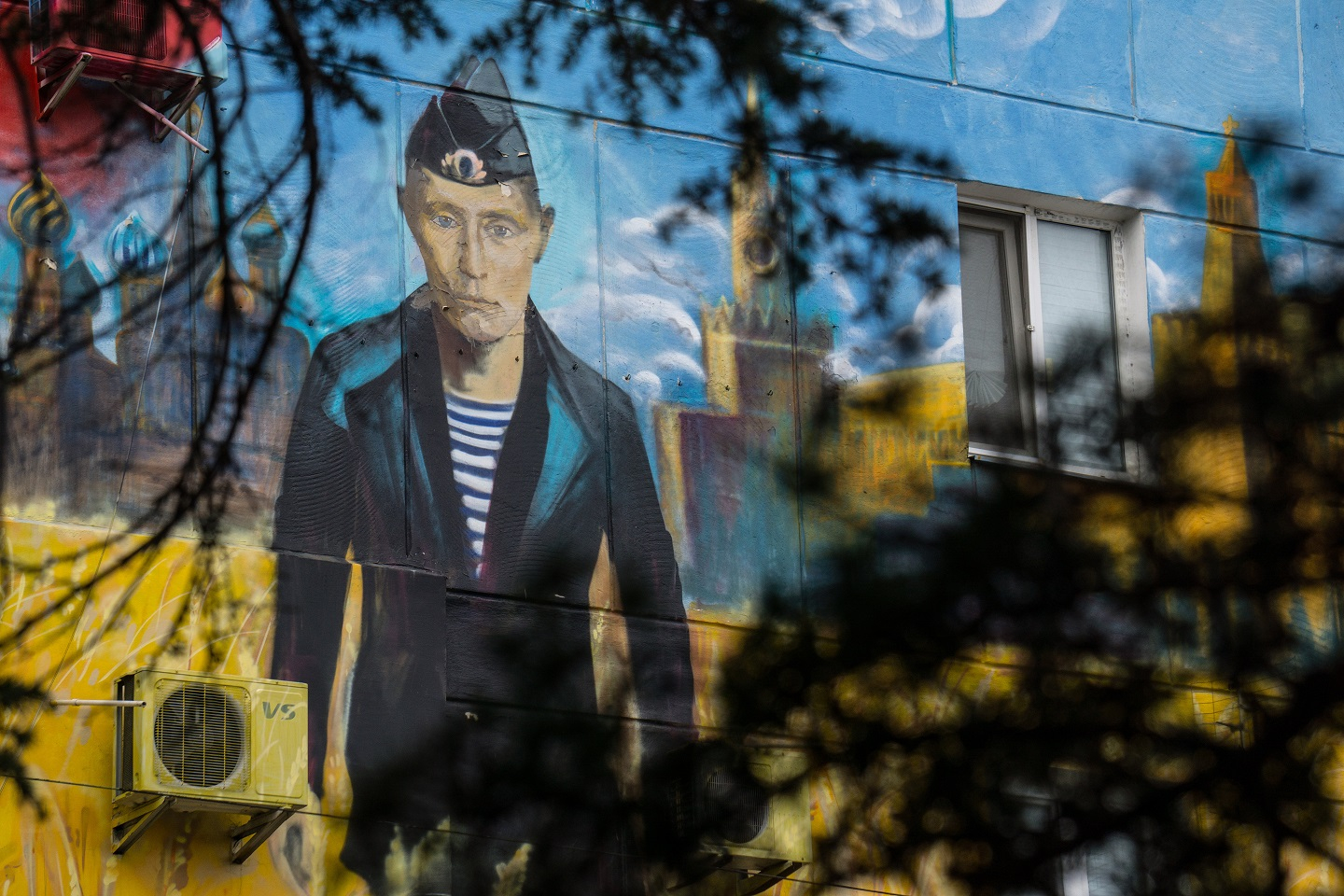
SEVASTOPOL, CRIMEA - AUGUST 12: An image of Vladimir Putin on one of houses in Sevastopol on August 12, 2015 in Sevastopol, Crimea. Russian President Vladimir Putin signed a bill in March 2014 to annex the Crimean peninsula but Ukraine and most of the international community do not recognize its annexation.
The reaction of Russian politics and diplomacy to its activities in Ukraine and also Georgia are partly overshadowed by statements that seem to imply that history started after March 2014. When discussing Crimea, the case is argued on two bases: First, in the outcome of the referendum of 16 March 2014, in which the local population expressed its will as part of their right to self- determination and second, the same behavior of the west with respect to Kosovo.
Both arguments can be challenged. There were no arguments of massive discrimination against any part of the Crimean population by any other part. This provides no foundation to refer to self-determination. It is furthermore disputed whether the right to self-determination may result in secession. As far as the Kosovo reference, and without entering into details as far as the different legal situation, it is sufficient to mention that even if the West had violated international norms, why would an immoral and illegal action serve as a legal precedent to follow rather than acting in the name of morality and choose to act differently?
Russia’s main objective in the so-called shared neighborhood (those six former Soviet republics that are also in the EU’s Eastern Partnership Program) is to create political dependencies and have countries on its western and southern perimeter be loyal to Russia and share its political course. It is not the objective of Russia to gain sovereign control over those states. This means that Crimea represents an exception. Beyond this, Russia intends to stay in the world political game. Apparently Russia is under the impression that troublemaking is an effective contribution to it.
Options for the West
The Russian Federation is taking a proactive stance, while the West is pushed into a reactive position. With this, Russia has dominated the action-reaction cycle, with the West constantly obliged to adjust to the flow of events determined by Moscow.
I. Continuation of the Current Trend
The West faces a shared self-perception of relative weakness. This is partly due to the objective rearrangement of power relations in the world because of the rise of some power centers and the relative decline of others, and partly due to a pessimistic perception resulting from recent developments. However, beyond this there is a broad variety of views about what the causes are and what the way out of the situation could be. The symptoms, though not shared, are clearly identified:
1. The challenge of hybrid threats is complex and must be addressed with a grand strategy. Such a grand strategy does not yet exist in the West; furthermore, it is difficult to imagine how it could be developed bearing in mind the volatilities and disagreements. As the concept of hybrid conflict keeps broadening, it is insufficient to develop a defense strategy, a grand strategy and a whole of government approach are necessary.
2. Three uncertainties and potential disagreements have to be mentioned:
- In some of his comments on NATO both during the election campaign and as president-elect, the U.S. president who came into office in January 2017 expressed his view that the alliance was obsolete. As NATO and its security guarantee is heavily dependent upon the commitment of the United States, such passing comments call into question the full-fledged U.S. commitment. Views expressed by senior members of the new administration compensate for these comments to a certain extent, giving ground for a different interpretation. Accordingly, the U.S. President extended an invitation to other members to reconsider and modernize the alliance. It is certainly premature to draw conclusions; it is necessary to wait at least until the next NATO summit in May 2017.
- The EU faces multiple crises, including those of Brexit, the Euro-zone (Greece), Ukraine, and migration. EU member-states have differing views on how to address them.
- The former cohesion that used to characterize the community of values upon which the EU has been based and of which the EU was so proud has been eroded from the inside. A number of member-states no longer meet those requirements, whereas a few others have to take into account the view of nationalist-populist forces unless they want to risk the possibility of being severely punished by the electorate in the next elections.
3. Generally, the unity of the West has weakened since the end of the Cold War. Short of a common adversary, many countries that define their security in regional (European) terms have significantly reduced their defense commitment. This has resulted in a situation where the average European NATO member-state spends 1.5 per cent of its GDP on defense, although recovery is under way. This level of spending—a low level in the eyes of some critics—is a result of moving away from territorial defense in the direction of focusing on power projection. This, however, is a slow and cumbersome process that is contingent upon a sustained level of threat. Lacking the perception of a common threat, it would be difficult to increase defense spending that may be more divisive than ever in the Alliance.
The threat perception has changed since 2014, however, and with NATO member-states facing an identifiable, “familiar” adversary, the situation started to change. The measures introduced entail the so-called “three D’s”: defense, deterrence, and dialogue. There is not yet full concord among NATO members about how those three elements shall relate to one another. While some simply would like to add more dialogue to defense and deterrence and thus create a new balance between them, others are of the view that dialogue should be based on a further upgrade of defense and deterrence. A similar idea underlined decisions in an earlier historical era. It is open to question what Russia’s reaction would be to one combination or the other.
For various reasons, we can extrapolate from the recent past and assume that continuation will prevail, including insufficient unity of the western countries either to further increase the pressure on Moscow or to reduce it. It has been a problem that many decision-makers in Moscow do not understand the working of certain international institutions, in particular those that are different from traditional intergovernmental organizations. The EU takes major decisions at painstakingly slow pace, however once a decision is taken, it may take similarly long time to opt out of it. It is essential to understand that once sanctions have been approved and introduced, discontinuing them now requires the consent of all the EU member-states. This is an often overlooked element and an area where the media in the EU member-states contributes to a false image. A gradual easing of the U.S. sanctions on the Russian Federation may have a snowball effect on some of the EU sanctions inter alia due to the fact EU economies are far more exposed to economic and human relations with Moscow than is the United States.
It has to be taken into account that Russia’s main concerns are far less the trade sanctions or the travel ban of certain Russian individuals (politicians, media personalities, etc.). It is the access to critical technologies and the long-term credits to refinance merchant banks. This situation is due to the following factors:
- Russia continues to import, partly with the help of “middlemen” (third states) and partly due to import substitution in some areas like agriculture where import substitution is not dependent upon massive investment or access to highly sophisticated technologies.
- The travel ban has remained limited and was lifted on an exceptional basis, both due to important state interests or for humanitarian reasons.
- Russia’s long term economic competitiveness is unimaginable without access to high technology in the longer run. Hence, Russia lobbied various western countries and the EU to change their stances on this matter and abolish or at least ease this element of the sanctions regime.
- The shortage of long-term credits has had similar effect in those areas requiring large-scale capital investment. Russia puts emphasis in its communications on those aspects of the sanctions regime where it faced no particular difficulties and avoids speaking of long-term negative consequences of sanctions. The West, to the contrary, emphasizes the successful elements of the sanctions and stops short on the losses the sanctions have caused economies in the EU. It is worth noting that although sanctions hold for understandable reasons, economically they are not favorable to any county involved.
II. Sudden Deterioration
Although it is not likely and may be imprudent to expect, it is possible that relations between Russia and the West could deteriorate unexpectedly. The Russian Federation may, in spite of propagating its resilience to western measures induced by its annexation of Crimea and interference in eastern Ukraine, perceive that it is massively losing out, cannot sustain its situation, and hence takes some desperate steps in order to reverse its fortunes. This may take the form of increasing the role of hard power in its external relations and in relative terms reducing the weight of soft power tools. The West may come under the influence of hardline forces that want to tighten the screws and further increase the pressure on Moscow. Both in Russia and in the United States, references have been made to the eventual use of nuclear weapons; Russia also made the employment of nuclear weapons part of its military exercises. Such allusions to nuclear escalation should send warning signals. These may be complemented by the occasionally voiced concern that the Russian leadership does not take decisions in accordance with established rules and hence the danger of subjective mistakes ought not to be underestimated. Bearing in mind the limited international political experience of some actors, similar subjective mistakes cannot be fully excluded on the western side. In sum, the situation may take unexpected turns even if they may not be in the long-term interests of the parties.
III. New Deal with Moscow
The Russian Federation is a difficult partner, however it is generally regarded a rational actor that can be influenced by various means. Since the election of Donald Trump as President of the United States and in light of his statements, the idea that the two powers could work to achieve a breakthrough between Russia and the West has gained some popularity. The matter is apparently highly divisive among the ranking members of the new U.S. administration. Some members of the cabinet, ranging from the Secretary of Defense to the U.S. ambassador to the United Nations, are ready to confront the Russian Federation while others, including the President, are ready to offer the benefit of doubt to Russia. As of now, the viability of this approach is based on tacit assumptions. No matter whether or not Russia is perceived to be a rational actor, questions include: To whom and what does Russia listen? How will it perceive this information and react to it? Does Russia reflect upon cooperative messages, diplomacy, or recognition of its role in the world? Or does Russia only listen to tough messages backed by dominant power? The answer to these questions may also determine the course that should be taken by the pertinent actors.
It would be premature to draw conclusions about the viability of such a novel approach. One has to state that such an approach has not been tried and hence it would be difficult to reject outright. It could be rather regarded an experiment be it unusual or even unprecedented. It is necessary to make two comments here:
- There is a wide spread of opinions in the West, including in the Atlantic Alliance. If the U.S. prematurely and carelessly achieves an earth shaking deal with Moscow without taking the broad array of views on board and taking them into consideration, it may raise doubts about the credibility of the Alliance in the capitals of some member-states. The Alliance relies to a large extent on the U.S. security guarantee.
- If the U.S. make a deal with Moscow without due regard to the views of its allies, it would support the Russian position that in NATO there is only one member-state that matters and calls the shots. Taken together, it is difficult to imagine a swift breakthrough and thus a fast improvement in the European security situation.
IV. Reestablish a “Working” West
The scenarios that have been outlined above could be induced by changes in Russia’s attitude and behavior. However, there are reasons to consider developments in the West that are essential to recreate a properly functioning West. It is necessary to base the West’s reaction on shared values and principles. Without this, the standing of the West would be eroded and its moral superiority destroyed. It was not due to the values proper but their impatient and intolerant realization that weakened the credibility of the West. The trust and “intimacy” should return to the relations and communications among western actors. The existing web of western institutions should become avenues of intensive exchanges and close coordination. It is essential that the relationship between the U.S. government and the EU/Europe be saved from turbulences. The efforts of external powers to drive wedges between various western players should be prevented by increased intensity of communications and information sharing. Finally, the western position should be better communicated to the population in order to weaken those populist efforts that are also supported by those external forces that are not interested in western unity.
Conclusions
- Current events and processes from which it is impossible to keep a distance often appear to be more complex and dangerous than ones that can be assessed historically.
- The security situation has visibly worsened since 2014 and does not show signs of rapid improvement. The West has to adapt to a situation that has deteriorated and find an adequate mix of responses to and defenses from Russia’s proactive and complex activity summarized as hybrid operation.
- It is essential that these western steps be based on its values and principles in order to regain the public support of its steps in spite of the intensive information campaign of the Russian Federation and its attempts to divide the West.
- It presents a challenge for the West to find an adequate policy mix relying on a combination of defense, deterrence and dialogue, reassurance to those allies that feel most exposed to the hostile atmosphere, and support the state that has faced aggression without endangering western unity.
- While the West should contribute to resilience, it should not lose sight of the need to develop a flexible grand strategy in order to be adequately prepared for the possibility of a lastingly unfavorable atmosphere in Europe and also to find areas of potential improvement. They should outline the mix of different means to be applied and serve as foundation of western coordination and unity. This emerging threat has created the clear need to build the foundation of a much closer coordination of responses.
For Academic Citation
Pál Dunay and Ralf Roloff, “Hybrid Threats and Strengthening Resilience on Europe’s Eastern Flank,” Marshall Center Security Insight, no. 16, March 2017, https://www.marshallcenter.org/en/publications/security-insights/hybrid-threats-and-strengthening-resilience-europes-eastern-flank-0.
About the Authors
Dr. Pál Dunay is Professor of NATO and European Security Issues at the Marshall Center and Deputy Director of the ESS-E.
Professor Dr. Ralf Roloff is the Senior German Professor (since 2003) at the Marshall Center and Director of the ESS-E.
The co-authors would like to acknowledge the stimulating insights and observations offered by our ESS-E speakers, participants, working group leaders, and the rapporteurs, and in particular 1st Lt Axel Fischer, and the leadership team.
The Marshall Center Security Insights
The George C. Marshall European Center for Security Studies in Garmisch-Partenkirchen, Germany, a German-American partnership, is committed to creating and enhancing worldwide networks to address global and regional security challenges. The Marshall Center offers fifteen resident programs designed to promote peaceful, whole of government approaches to address today’s most pressing security challenges. Since its creation in 1992, the Marshall Center’s alumni network has grown to include over 13,715 professionals from 155 countries. More information on the Marshall Center can be found online at www.marshallcenter.org.
The articles in the Security Insights series reflect the views of the authors and are not necessarily the official policy of the United States, Germany, or any other governments.
